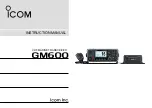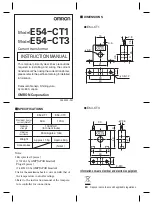
Page 17
HUGO SACHS ELEKTRONIK - HARVARD
A P P A R A T U S
GmbH D-79232 March-Hugstetten Germany
HSE PLUGSYS
®
TAM-A Type 705/1 and TAM-D Type 705/2
7. Zero compensation ZERO
Zero compensation is required to correct the transducer zero without any load on. The output signal of e.g. a
Wheatstone bridge without any loading is never exactly zero. Possible causes are manufacturing tolerances in
the branch resistances, the effect of position, or slight bridge unbalance through overload or compensation of an
applied preload. Zero compensation consists of feeding a compensating current into the transducer bridge
circuit. In this way zero compensation is independent of the amplification selected on the TAM. TAM offers
manual coarse and fine adjustment as well as a very precise autozero function in order to compensate even
extreme symmetry errors in a transducer bridge.
7.1 Manual zero adjustment
The effect of the COARSE zero adjustment is larger than that of the FINE adjustment by a
factor of 5. In order to use the adjustment range of the FINE adjustment in both positive and
negative directions it is necessary first to move the FINE adjustment roughly to its centre
position. Turn the multi-turn adjustment fully anticlockwise (19 turns) and then about 8 turns clockwise. The same
applies to the autozero function, see description below (Section 7.2).
Coarse adjustment with the ZERO COARSE adjustment
Fine adjustment with the ZERO FINE adjustment
Precise zero with the autozero function
N o t e : On TAM-D it is in principle also possible to make the precise zero adjustment
using the built-in digital display and the FINE manual adjustment. It is therefore
not essential to produce precise zero adjustment using the autozero function. On
TAM-A however, accurate zeroing is not possible in this way because of the limited
resolution of the bargraph. Precise zero adjustment on TAM-A requires the use of
the autozero function.
7.2 Automatic zero adjustment.
Automatic zero compensation (autozero function) operates digitally with a resolution of 12 bit.
This provides an adjustment range of 4096 steps (±2048 steps). Zero adjustment operates
directly on the amplifier input and the zero shift per step therefore depends on the internal
resistance of the transducer and on the gain setting (see Section 4.2.5, Zero coupling). The
autozero setting is stored permanently and remains held until the next automatic zero adjustment even if the
amplifier case is switched off.
Automatic zero adjustment is possible only in operating mode MEASURE. Starting autozero
in the mode OFF or CAL results in an error, the status LED above the AUTO key flashes briefly 4 times.
R
Autozero can only be initiated after a waiting time of 2 seconds. This means that the
AUTO push button must be held down for at least 2 seconds. This prevents unintentional
initiation of a zero adjustment. Throughout the adjustment the status LED shows a
steady light. After successful zero adjustment the status LED goes off immediately. In case the autozero
adjustment range is not sufficient, the status LED flashes 15 times at the end of the adjustment. In
addition the automatic system is normalised to the centre of the adjustment range. In order to proceed
with zeroing the zero position has to be corrected manually. Automatic adjustment should then be possi-
ble (see also autozero coupling Section 4.2.5).
R
In order to move autozero to its mid position the transducer has to be disconnected from the TAM and
autozero is started. Since zeroing is now impossible the autozero function makes an unsuccessful attempt
at zeroing and then normalises itself to its mid position.
R









































